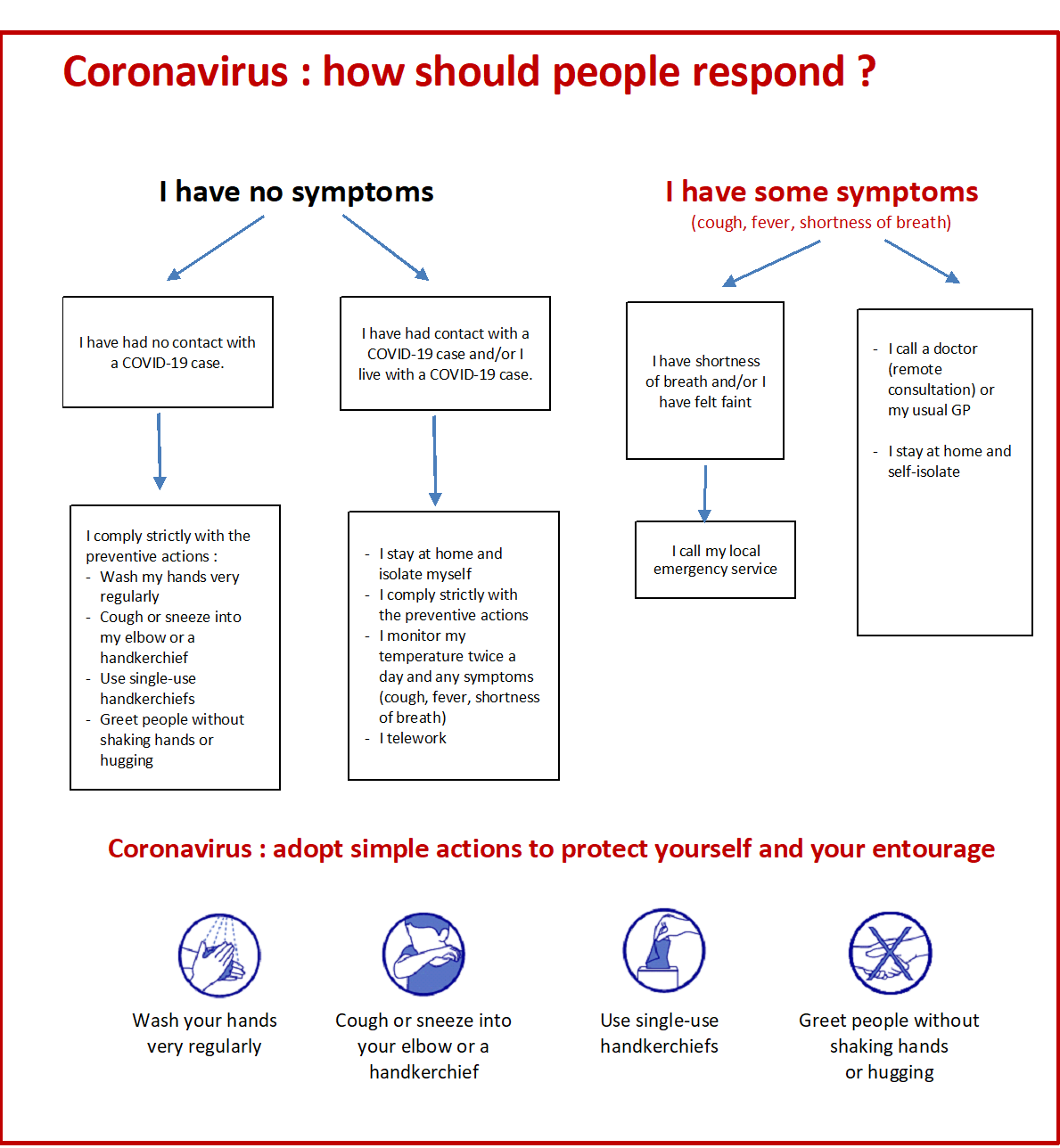Covid-19 and community life
Sheet prepared for EMI members in April 2020
The COVID-19 Coronavirus
- Coronaviruses are a large family of viruses which cause illnesses which range from a simple cold (some seasonal viruses are Coronaviruses) to more serious diseases such as MERS-CoV or SRAS. The virus identified in January 2020 in China is a new Coronavirus called COVID-19. The illness may be benign (no symptoms or a simple cold) or it may cause shortness of breath that may be so serious as to need hospitalisation in intensive care and even lead to death.
- A virus, unlike a bacterium, cannot be treated with antibiotics. There is no vaccine against COVID-19. Your first concern must therefore be to protect yourself and to protect your entourage.
- Since 11 March 2020, the World Health Organization (WHO) has described the situation regarding COVID-19 around the world as a pandemic ; in other words, the epidemic is now global.
Infection by the Coronavirus
- COVID-19 is spread by people who are carriers of the virus. The illness is spread from one person to another by droplets in a person’s breath that are expelled through the nose or the mouth when they cough or sneeze. That’s why it’s important to keep more than one metre away from a sick person.
- These droplets may fall onto objects or surfaces around the person in question. You can therefore contract COVID-19 if you touch these objects or these surfaces and if you then touch your eyes, nose or mouth. That’s why you need to clean surfaces and wash your hands carefully and repeatedly.
Signs of having contracted COVID-19
- The main symptoms are a fever or feeling of a fever and a cough.
- The sudden loss of a sense of smell with no nasal obstruction or total loss of taste are also symptoms which have been noted in patients.
People at risk
- People aged 70 and over
- Chronic respiratory failure patients under oxygen therapy or suffering from asthma or cystic fibrosis or any chronic respiratory disease that may be aggravated by a viral infection
- Chronic dialysed renal failure patients
- Heart failure patients
- Cirrhosis ≥ stage B patients
- Cardiovascular history: high blood pressure, stroke or coronary artery disease, heart surgery patients
- Insulin-dependent diabetes patients or those with secondary complications with respect to their pathology
- Immunodeficient patients: Medically-induced (cancer chemotherapy, immunosuppressive therapy, biotherapy and/or immunosuppressive dose corticotherapy), Cancer patients under treatment, etc
- Morbid obesity BMI > 40
- Pregnancy in the 3rd trimester
Signs of severity of Covid-19
- Be a person at risk
- Rapid breathing, shortness of breath
- Mottled skin, blue lips, purple fingertips
- Impaired consciousness: confusion, drowsiness
- Dehydration
Behaviour to adopt
The diagram below summarises the behaviour to adopt in different situations.

General communal-living precautions
In a shared house, it is recommended you :
- Self-isolate, avoid contacts and keep 1 metre away from others
- Adopt preventive actions (see above)
- Regularly air rooms
- Avoid touching shared objects
- Wash frequently-touched surfaces daily (handles, remote controls, mobile phones, etc.).
- Receive only essential visits, such as from doctors.
Precautions if a person has the virus in a community
For the patient :
- Keep isolated in a specific room
- Monitor their temperature twice a day
- If their general condition worsens, call a doctor
For their entourage, apply the following measures:
- Monitor their temperature twice a day and signs of respiratory problems
- In the event of fever or respiratory symptoms in a member of the entourage, contact a doctor
Cleaning of floors
- Do not use a vacuum cleaner
- Clean floors and surfaces with a detergent-soaked wash cloth
- Then rinse with tap water with another single-use wash cloth.
- Then leave to dry
- Then disinfect the floors and surfaces with bleach diluted to a concentration of 0.5% active chlorine (1 litre of 5% household bleach + 9 litres of water).
Treatment of a virus sufferer’s linen and dishes
- Do not shake sheets and linen.
- Take their sheets and laundry straight to a washing machine without putting them down in an intermediate place and keep them away from the body.
- Wash the bed linen of a confirmed patient in a washing machine using a programme that washes at 60 degrees for at least 30 minutes.
- Wash their dishes in warm water and soap or dishwashing liquid.
Taking care of the body in the event of death by COVID-19
- Before entering the room, if possible wear overalls and a plastic apron, a hairnet or cap, a surgical mask and protective goggles, all single use.
- Wash the body only in the room in which it has been laid out, using single-use equipment if possible.
- Wrap it in a hermetically-sealed body bag.
- Cover the transport stretcher with a single-use sheet.
- Before leaving the room, clean the body bag cover with a single-use wipe, pre-soaked in disinfectant detergent or bleach.
- Remove all waste.
For the undertakers
- Do not open the bag,
- Cover the body bag with a sheet for transfer to the funeral parlour.
- Lay the body in a simple coffin
- Close the coffin permanently without delay
- Do not carry out any embalming or thanatopraxia